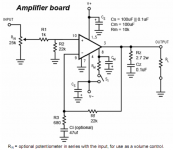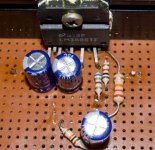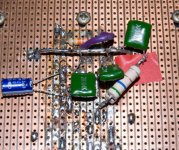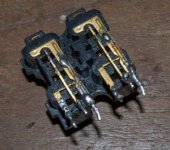Hello, I've built a amp using the following schematic and i want to know if the optional Ci capacitor must be a "non polar" capacitor. And also i get a hum when no source is connected and it goes away when the source (preamp) is connected and switched, i dont use the Rin. I would also like to know if i can use a input DC blocking cap, if i can what value should i use.
Thankyou for all your answers.
Daniel
Thankyou for all your answers.
Daniel
Attachments
Hi,
Ci, in the Negative FeedBack loop, can be a film type or electrolytic.
The electrolytic is supposedly better if of the non-polar but I have not heard a difference here.
The schematic shows DC coupling on the non-inverting input and AC coupling on the inverting input.
I always recommend that both inputs have the same AC or DC coupling.
The High Pass Filter formed by these DC blocking caps must be low enough to pass your audio signal.
I recommend about 2Hz for the input cap, 1.4Hz for the NFB cap and 1Hz for the PSU caps. This leaves the input LPF and HPF as the band limiting filters for the amplifier.
Add a LPF to the input.
Ci, in the Negative FeedBack loop, can be a film type or electrolytic.
The electrolytic is supposedly better if of the non-polar but I have not heard a difference here.
The schematic shows DC coupling on the non-inverting input and AC coupling on the inverting input.
I always recommend that both inputs have the same AC or DC coupling.
The High Pass Filter formed by these DC blocking caps must be low enough to pass your audio signal.
I recommend about 2Hz for the input cap, 1.4Hz for the NFB cap and 1Hz for the PSU caps. This leaves the input LPF and HPF as the band limiting filters for the amplifier.
Add a LPF to the input.
Hi Andrew,
I'm new to this and will really appreciate it if you could make your explaination more simple.
Thank You
I'm new to this and will really appreciate it if you could make your explaination more simple.
Thank You
Hi,
Ci is in the NFB loop. agreed?
This is the DC blocking cap and converts the inverting input (pin9) to AC coupled. agreed?
The non-inverting input (pin10) is DC coupled.
A DC blocking cap should be added here to convert this input to AC coupling to match pin9.
Ci is in the NFB loop. agreed?
This is the DC blocking cap and converts the inverting input (pin9) to AC coupled. agreed?
The non-inverting input (pin10) is DC coupled.
A DC blocking cap should be added here to convert this input to AC coupling to match pin9.
hi andrew i put a 1uf input cap but there is still noise when no input is connected. i cant really call it a hum is more like a buzz it just dissappears when a input is connected.
danielnaveen said:hi andrew i put a 1uf input cap but there is still noise when no input is connected. i cant really call it a hum is more like a buzz it just dissappears when a input is connected.
It seems like your input isn't shielded as it should be. Connect a 100k or bigger resistor between R1 and ground, as close as possible to the input.
Mine is also on strip board, but I don't have hum at all, I used shielded cables for signal and they don't intersect any other cables. I'm using RCA connectors for inputs and star grounding. On my system the 100k resistor is placed on the connector, before R1 along with 100pF in parallel to avoid RF interferences.
well maybe it'll just go away if i put the amp in a case and use shielded cables. i just dont understand y it buzzes when there is no input and become dead quiet when a source is connected.
danielnaveen said:cct? I haven't earthed the amplifier if thats what your asking.
Try connecting a wire from ground (star ground), to an earth point in house.
ok i earthed the star ground and noise have reduced a lot but there still is a buzz which goes away on connecting a source. will this go away if i use a ground loop isolator like rod elliot uses in his powersupplies?
danielnaveen said:ok i earthed the star ground and noise have reduced a lot but there still is a buzz which goes away on connecting a source. will this go away if i use a ground loop isolator like rod elliot uses in his powersupplies?
i think there a input offset issue.do you have a pot install between the source and power stage?
z
- Status
- Not open for further replies.
- Home
- Amplifiers
- Chip Amps
- LM3886 chip amp help



